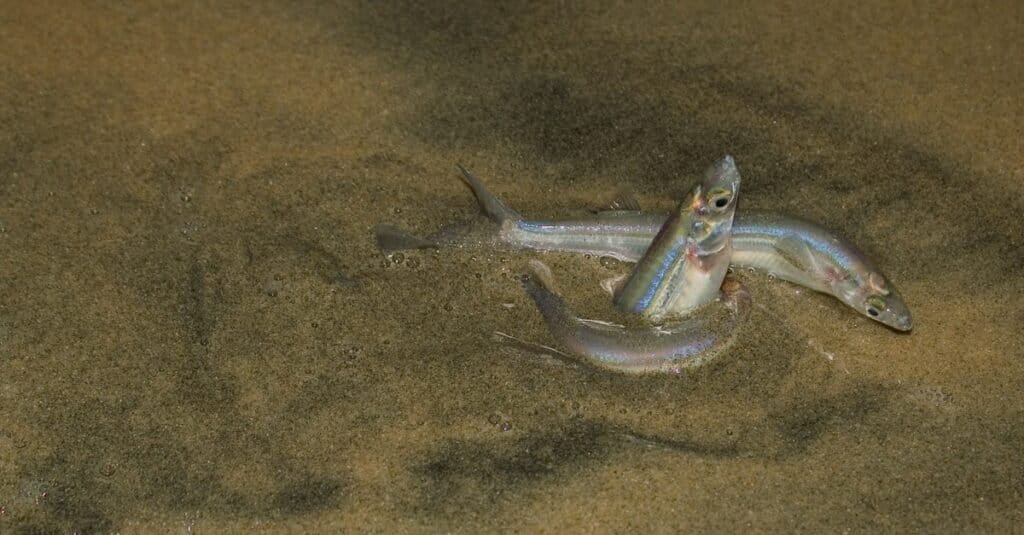A grunion run refers to the activity of catching grunion when they come out at night to spawn during the spring and summer in Southern California. Grunion refers to two species of marine fish, the Gulf grunion and the California grunion. There are rules for California grunion runs during their spawning on the beach, including grunion season and how to protect grunion, as well as ways to see the fish at night. Here’s what you need to keep in mind to make the best of your grunion run.
What Does A Grunion Run Involve?
Other fish spawn on beaches, but none of them do so completely out of the water as grunion do. You don’t catch grunion the same way you would catch other fish, as in by fishing in a body of water, although you still need to have a fishing license. Instead, you catch them by hand. That’s because catching them is only allowed during grunion season, which is when they are spawning on a California beach. It’s illegal to fish for them so that their population doesn’t end up over-harvested. Plus, nobody really knows where the mysterious fish go after spawning, anyway. As a unique species, grunion is only found off the coast of California, making it especially important for the ecosystem of the California beach.

©Loren Rodgers/Shutterstock.com
What Can You Do With Grunion?
Grunion makes excellent fishing bait for predator fish, staying on the hook and not breaking down, unlike anchovies. As moderately fatty fish, it is enjoyed sauteed, deep-fried, or broiled. Catching and releasing grunion is popular for people who don’t intend to eat them or use the fish as bait.
When Are Grunion Runs Held?
Grunion season is during the months of March through September, on the beaches along the Pacific coast. In California, it happens in the southern region, including Point Conception, Baja, and Santa Barbara. The fish’s spawning happens during or following new and full moons. April, May, and June are peak spawning periods, which is when grunion runs are larger and you are most likely to see them. The Department of Fish and Wildlife reports for expected grunion runs include four nights after new and full moons. They are most likely to happen during the second, third, fourth, and fifth nights after the full or new moon, with the third and fourth nights being the best. There is a two-hour window after high tide where the fish are most likely to appear.
How to Go on a Grunion Run
It’s easy to recognize grunion by grunion runs. During a grunion run, the female fish go onto the beach to lay eggs high up on the shore, and the males follow to fertilize them. Although spawning typically starts on the nights after full and new moons, grunion runs can happen during the daylight hours when there’s a high tide.
On the other hand, the fish is elusive. Your best bet of seeing it is at night, which is more fun, anyway. It avoids flashing lights, crowds, and noise, and prefers soft, sandy, flat beaches. It also tends to spawn at the ends of beaches. Southern California has the largest grunion runs, with smaller grunion runs happening farther north. However, this also means that the spots with the larger grunion runs may also be the noisiest and most crowded, making it more difficult to catch the fish.

©iStock.com/Steve Howard
Tips to Remember About a Grunion Run
- How to keep grunion protected: Remember the law. April and May are off-season or closed months, which is when you cannot take or have any contact with the fish. To catch grunion before and after April and May, you must have a valid Department of Fish and Wildlife license for anyone over the age of 16. Nobody can use any gear, including buckets, traps, hooks, or nets, as catching them is only allowed with your bare hands. It’s also illegal to catch fish you do not intend to use unless you are catching and then releasing them.
- How to best see grunion at night: There are two high tides along the Pacific coast of North America, with the higher tide happening at night during the spring and summer months. Only on the higher tides and after they have begun receding will you see grunion spawn. During this time, you also have to compete with birds waiting to feast on the fish. To be more likely to see and catch them, you’ll want to find a beach that is flat and sandy rather than steep and pebbly. You’ll also want a beach that is long and wide, so you’ll be safe and not risk being pushed up against the bluffs during high tide. When the grunion show up, you will notice they are sardine or hotdog-sized, about 5-6 inches. They have silver sides, silver bellies, and bluish-green backs. Keep as quiet as possible and keep light down to a minimum so you don’t scare them away.
Conclusion
Grunion is a small, unique fish famous for spawning completely out of the water on California beaches. The term “grunion run” refers to both the appearance of the fish while spawning as well as the art of catching them. It is a fun way to catch the fish at their most plentiful without endangering the species. If you remember the rules, you can go on a grunion run safely and practice your skill at catching fish by hand.
NEXT UP…
- Water Dogs VS Axolotls VS Water Puppies
- 10 Incredible Fish Facts. If you love fish as much as we do you will enjoy these fun facts
- Sardines vs Anchovies: What’s the Difference?
The photo featured at the top of this post is © iStock.com/Steve Howard
Thank you for reading! Have some feedback for us? Contact the AZ Animals editorial team.






